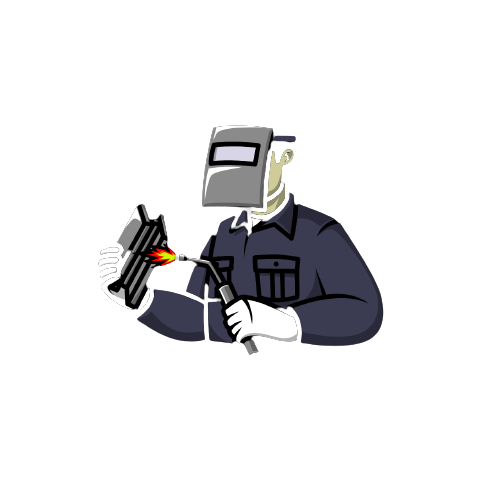Starching a welding shirt is not just about maintaining its crisp and neat appearance; it’s also about enhancing its protective capabilities. The act of starching a welding shirt fortifies the fabric, making it more resistant to sparks and spatter. However, the process is not as straightforward as starching a regular shirt.
There are particular steps and precautions that need to be considered. This comprehensive guide will walk you through the entire process of starching a welding shirt, ensuring you are adequately protected while looking professional on the job.
Why do Welders Starch their clothes?
Starching is a common practice among welders, and for good reasons. Welders work in environments where sparks and spatter are common, and these can cause burns or even ignite clothing. Starching welding clothes helps in creating a barrier that makes the fabric more resistant to these hazards.
It essentially stiffens the fibers of the fabric, making it harder for sparks to penetrate and reach the skin. This is not only about enhancing safety but also about prolonging the life of the clothing.
- Starching creates a barrier against sparks and spatter.
- It stiffens the fibers of the fabric, making it harder for sparks to penetrate.
- Helps in prolonging the life of the clothing by reducing burns and holes.
- Starched clothes look more professional and neat.
- Enhances safety by reducing the chance of clothes igniting.
While safety is the primary reason welders starch their clothes, it also has the added benefit of making the clothes look more professional and neat.
How do you Starch a Welding Shirt?
Starching a welding shirt involves a few essential steps that need to be followed to ensure the best results.
- Start by washing and drying your shirt.
- Prepare the starch mixture by either buying liquid starch or dissolving starch powder in water.
- Lay the shirt flat on a clean surface.
- Apply the starch mixture evenly on both sides of the shirt using a spray bottle or a clean sponge.
- Use a hot iron to press the shirt. The heat from the iron will help the starch to bond with the fibers of the fabric.
- Hang the shirt to dry completely before wearing or storing it.
It is essential to apply the starch evenly and not to over-saturate the shirt as it can leave residues. Using a hot iron will not only help in bonding the starch to the fabric but will also remove any wrinkles.
Make sure to hang the shirt to dry completely before wearing or storing it. It is also advisable to do a patch test on a small, inconspicuous area of the shirt before applying the starch all over, to ensure it does not react adversely with the fabric.
Can all Welding Fabrics be startched?
Not all welding fabrics are suitable for starching. Welding shirts are usually made of flame-resistant (FR) materials like treated cotton or synthetic fibers that have specific care requirements to maintain their flame-resistant properties. Starching can sometimes interfere with the flame-resistant properties of the fabric, making it less safe to wear while welding. It’s essential to check the manufacturer’s care instructions and recommendations before starching any welding shirt.
- Flame-resistant materials may not be suitable for starching.
- Starching can interfere with the flame-resistant properties of the fabric.
- Always check the manufacturer’s care instructions before starching a welding shirt.
For welders, it’s crucial to wear 100% cotton or wool clothing as they are less likely to catch fire and easier to extinguish compared to synthetic materials, which can melt and cause burns instantly. Denim is also suitable, but it must be 100% cotton and free of synthetic blends.
What Equipment is needed for Startching a Welder Shirt?
Starching a welding shirt involves a simple process but requires some essential equipment to get the job done properly.
- Starch: Liquid starch is preferable as it is easy to apply and dries quickly.
- Spray Bottle: A spray bottle to mix the starch solution and apply it evenly onto the shirt.
- Iron: A good quality iron to press the shirt after applying the starch.
- Ironing Board: A flat, stable surface like an ironing board to lay the shirt on while ironing.
- Clean Towel or Cloth: To wipe off any excess starch from the iron or the shirt.
- Water: To mix with the starch and fill the spray bottle.
First, mix the starch and water as per the instructions on the starch bottle. Fill the spray bottle with the mixture. Lay the shirt flat on the ironing board and spray the starch solution evenly on both sides of the shirt. Let it soak for a minute and then iron the shirt as usual. Make sure to iron every part of the shirt thoroughly, paying special attention to the seams and edges.
Wipe off any excess starch with a clean towel or cloth. Repeat the process if necessary until you achieve the desired level of stiffness. It is important to remember that too much starch can make the fabric brittle, so it’s better to apply several light coats rather than one heavy one.
Should you Starch your Welding Shirt?
Starching your welding shirt can offer several benefits, making it an important consideration for any welder. It not only makes your shirt stiffer, which can help in preventing sparks and spatter from reaching your skin, but it also makes the shirt more resistant to dirt and grime. Moreover, a starched shirt is easier to clean and maintain.
As a welder, your safety and comfort are paramount. Investing in the right kind of welding shirt and maintaining it properly can make a significant difference in your day-to-day work. Interested in knowing more about the best welding shirts available? Check out our guide to the “Best Welding Shirts to Buy in 2023”, and make an informed choice.
Happy Welding!
FAQs
Some commonly asked questions regarding Welder shirt starching are:
How do you starch stiff clothes?
To starch stiff clothes, mix a solution of starch and water according to the instructions on the starch packaging, dip the clothes in the solution, wring out excess, and iron the clothes until they are dry. This will make the clothes stiff and crisp.
Should I starch my welding shirt?
Essentially, starch acts as a barrier that hinders the accumulation of dirt on fabric. If, by chance, dirt does gather on your welding attire, it can be washed off with ease. Moreover, starch aids in repelling sparks, slag, and spatter, thereby preventing them from permeating your clothes.
This translates to an added layer of protection for your skin against potential burns. Additionally, starching your welding shirt can provide a crisp, professional appearance while also helping the fabric maintain its structure during a demanding day of work.
Is spray starch bad for shirts?
Spray starch is not inherently bad for shirts, but it is important to use it correctly. Excessive use can lead to build-up on the shirt and the iron, and it may attract pests over time. Always follow the instructions on the can and test on a small, inconspicuous area first.
How long does spray starch last?
The effect of spray starch typically lasts until the next wash. However, the can itself, if stored properly, can last for about 2 years. Be sure to check the expiry date before use.
Can Starch go bad?
Homemade starch, made from natural ingredients, typically has a short shelf life of one to two weeks maximum. In contrast, commercial starches contain added chemicals to extend their shelf life significantly.
How to Starch a Welding Jacket?
To starch a welding jacket, first, clean the jacket thoroughly. Then, prepare a starch solution according to the instructions on the starch product, and evenly spray or brush the solution onto the jacket. Lastly, iron the jacket on a suitable setting for its material to evenly distribute the starch and remove any wrinkles.

